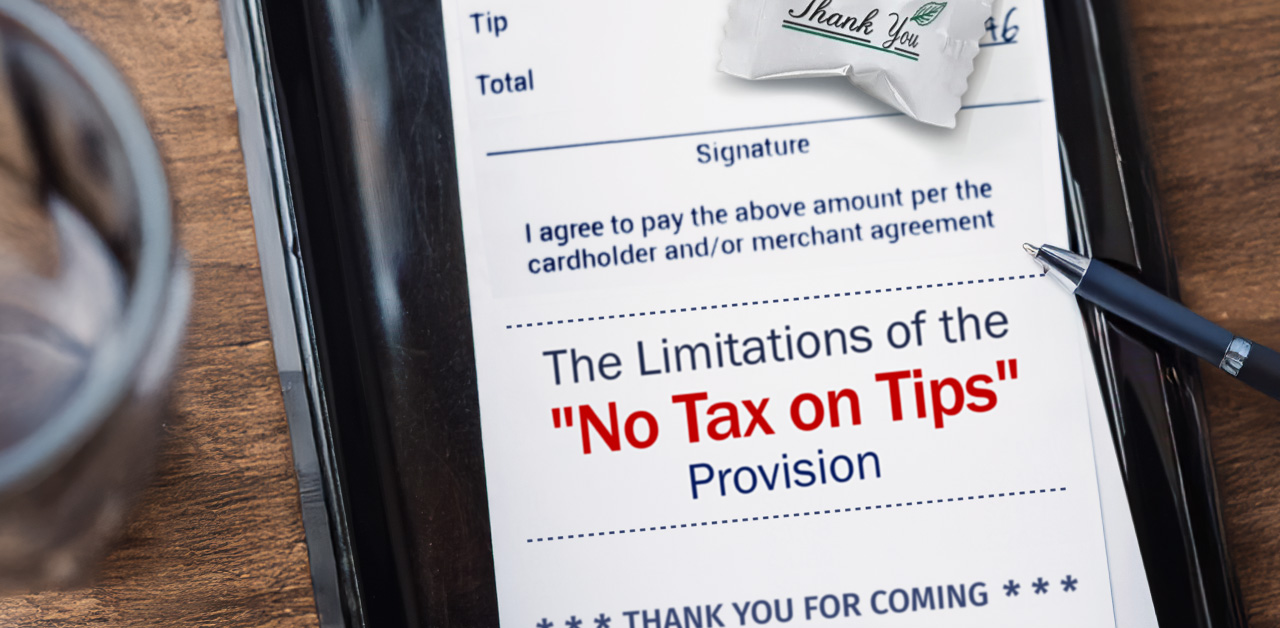Contact Us : 800.874.5346 International: +1 352.375.0772

The promise of tax-free tips sounds like a dream come true for millions of service workers across America. The provision, while well-intentioned, comes with restrictions and limitations that could reduce its actual impact. Understanding these limitations isn’t just important—it’s essential for anyone working in the service industry to know whether they’ll benefit from this policy. In this deep dive, we’ll explore the three categories of limitations that could determine whether your tips become tax-free: eligibility requirements, financial caps, and complex procedural barriers.
The first limitation lies in who qualifies for tax-free tips. According to Section 224(d)(1) of the legislation, only “cash tips received by an individual in an occupation which customarily and regularly received tips on or before December 31, 2024″* qualify for the deduction. This seemingly simple requirement creates several barriers.
*Note: The IRS will have an official statement on eligible industries with guidance no later than 10/2
First, there’s the “customarily and regularly” standard. If your occupation didn’t have an established tipping culture by December 31, 2024, then it does not qualify. This means emerging service roles or industries that might develop tipping practices after this date will not be held to this standard. Additionally, the tips must be “paid voluntarily without any consequence in the event of nonpayment” (Section 224(d)(2)(A)). This excludes automatic service charges, mandatory gratuities, or any tip that customers are required to pay.
The definition of “cash tips” is broader than it might seem, including “tips received from customers that are paid in cash or charged and, in the case of an employee, tips received under any tip-sharing arrangement” (Section 224(d)(3)). However, this still excludes other forms of compensation that might be considered tips in practice but don’t meet the legal definition.
The provision caps the annual deduction at $25,000 (Section 224(b)(1)), which might seem generous but becomes restrictive for high-earning service workers in upscale establishments.
More restrictively, the benefit phases out based on income. For every $1,000 your modified adjusted gross income exceeds $150,000 ($300,000 for joint filers), your deduction reduces by $100 (Section 224(b)(2)(A)). This means that if you’re a single filer earning $400,000, you’d lose the entire benefit. The phase-out ensures that higher-income earners receive progressively less benefit, which, while potentially equitable, limits the provision’s scope.
For self-employed individuals, there’s an additional complexity. According to Section 224(c), tips received in the course of a trade or business can only be deducted “to the extent that the gross income for the taxpayer from such trade or business for such taxable year (including such qualified tips) exceeds the sum of the deductions… allocable to the trade or business.” This means if your business expenses equal or exceed your gross income, you can’t claim the tip deduction.
The third limitation involves the complex procedural requirements that could trip up many workers. The legislation requires that tips be “included on statements furnished to the individual pursuant to section 6041(d)(3), 6041A(e)(3), 6050W(f)(2), or 6051(a)(18), or reported by the taxpayer on Form 4137” (Section 224(a)). This means you need proper documentation from employers or payment processors—something that might not always be readily available.
A critical requirement is that “no deduction shall be allowed under this section unless the taxpayer includes on the return of tax for the taxable year such individual’s social security number” (Section 224(e)(1)). This seemingly simple requirement can be a barrier for workers who might have documentation issues. For married individuals, “this section shall apply only if the taxpayer and the taxpayer’s spouse file a joint return for the taxable year” (Section 224(f)). This means married couples filing separately cannot claim the deduction at all, regardless of their individual circumstances. Perhaps most significantly, the entire provision has a built-in expiration date. According to Section 224(h), “No deduction shall be allowed under this section for any taxable year beginning after December 31, 2030.” This means the benefit is temporary, lasting only about six years from implementation.
The “no tax on tips” provision represents a meaningful attempt to provide tax relief to service workers, its limitations are substantial and could significantly restrict its real-world impact. The eligibility requirements exclude many workers, the financial caps reduce benefits for higher earners, and the procedural barriers create compliance challenges. Most importantly, the temporary nature of the provision means any benefits will disappear after 2030 unless Congress acts to extend them.
Understanding these limitations is crucial for service workers to set realistic expectations and for policymakers to recognize where improvements might be needed. The provision isn’t a universal solution—it’s a targeted benefit with specific constraints that will determine its ultimate effectiveness.
If you’re a service worker, review these limitations carefully to determine if you qualify and what documentation you’ll need. Consider consulting with a tax professional to navigate the complex requirements. For policymakers and advocates, these limitations highlight areas where the legislation might be refined to better serve the intended beneficiaries. Share this information with fellow service workers to ensure they understand both the opportunities and the obstacles ahead.
Garrett W. Gleim, CPA, CGMA, leads production of the CPA, CMA, CIA, and EA exam review systems at Gleim. He holds a Bachelor of Science in Economics with a concentration in Accounting from the Wharton School, University of Pennsylvania. He is a member of the American Institute of Certified Public Accountants (AICPA) and the Florida Institute of Certified Public Accountants (FICPA). Also an active supporter of the local business community, Garrett serves as an adviser to several startups. He is an avid pilot and is certified as a flight instructor and commercial pilot.